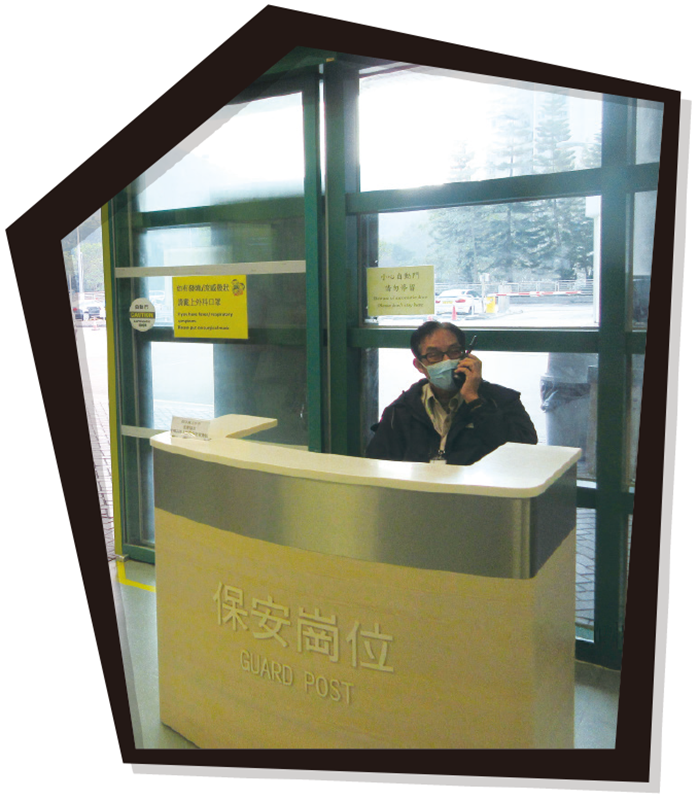Learn from past cases
If a violent incident occurs in the workplace, the on-site supervisor shall work closely with the Occupational Safety and Health team, security staff and hospital management to handle, investigate and review the case, in addition to providing immediate support to the victim, so that colleagues from other departments can also draw on their experience.
Case 1: Offensive language and intimidation @ General Out‑patient Clinic (GOPC)
A male patient visited a GOPC for wound cleaning. When the nurse on duty asked him about the wound location, he took her as unprofessional and cursed her with agitation, claiming that he would make a complaint. As he requested to be taken care of by another nurse, the nurse asked him to wait outside. He refused and reacted as if he was going to slap her face, yelling “I will beat you up after you are off-duty!” Startled and shocked, the nurse asked her colleagues to report the incident to her supervisor and the police. The patient was found to have violated the Hospital Authority Bylaws by using offensive language in hospital and was fined $800. He was also charged criminal intimidation by the police and sentenced to three-week imprisonment.
Learning tips
1. Keep calm when a patient is in a state of agitation. Try to show empathy with active listening. Use de‑escalation techniques to calm down the patient and try to resolve the problem.
2. Be sincere, certain and confident. Avoid using judgmental and subjective wordings.
3. Stay at a safe location when necessary.
Case 2: Intimidation and violence @ Accident and Emergency Department
A patient was admitted to A&E Department due to loss of emotional control and sitting dangerously at a high place. At midnight, he suddenly had an emotional outburst and shouted around to demand for discharge. When Nurse A attended to him, he picked up a pair of scissors from the nurse station and pressed against A’s neck. Nurse B tried to push the patient away, during which he seized B after pushing A down. The police received the report and controlled the patient after arrival. Both nurses were injured.
Learning tips
1. Avoid putting objects that can be used as weapons at prominent places. Use tools of lower risks, e.g. blunt tip scissors.
2. Arrange security guard patrolling around high risk locations or set up guard post when necessary.
Case 3: Nuisance @ Psychiatric Specialist Out-patient Clinic (SOPC)
Over 20 patients were queuing for registration at a psychiatric SOPC. Patient Care Assistant C who is responsible for crowd control, asked a patient who came for follow‑up consultation to queue up after seeing him jumping the queue. The patient got abusive and replied, “It’s none of your business! Others in the line don’t say a word about it. So who are you to stop me?” A security guard on duty tried to assist but was futile. While the patient continued to demand immediate registration, supervisor of C called the police after learning about the incident and the security guard informed the on‑duty foreman for support. The patient was prosecuted and was fined $2,000 for violating Hospital Authority Bylaws.
Learning tips
1. When approaching a potentially violent patient, keep sideways stance with front and rear legs in a protective posture. Stay at least one arm’s length from the assailant.
2. Be sincere, certain and confident. Avoid using judgmental and subjective wordings.
3. Observe the mental state and behaviour of patient continuously. In case of any abnormality, call for help immediately and handle it in a team approach.
Case 4: Dissatisfaction of patient’s family due to service postponement @ Patient’s home
Community Nurse D informed Patient B about the postponement of home visit by phone call prior to the visit. When D was conducting body check for B in the living room, B’s son showed dissatisfaction beside and shouted at D with foul language, “Why are you so late? I have to rush for work.” D tried to explain but her effort ended up in vain. He pushed D, who felt threatened and left patient’s home at once. She immediately informed her supervisor and reported to the police.
Learning tips
Before home visit:
1. Carry out risk assessment, e.g. obtain information on patient’s history of violence.
2. Bring personal protective equipment and communication tools, e.g. safety alarm and mobile phone.
3. Arrange joint visit for the first visit to learn about patient’s living environment and family members’ conditions.
4. Inform community nursing services centre the arrival time and expected departure time from patient’s home. Let patient and family members know if there is any postponement of home visit to avoid misunderstanding.
5. Look for cues that are not conducive for home visit, e.g. quarrelling.
During home visit:
6. Sit near the door for easy escape.
7. Be friendly and attentive to patient’s needs. Reassure patient and give explanations when appropriate.
8. In case of violence, leave the scene at once and activate the safety alarm or call police under safe condition.
COVER STORY
● Comprehensive education to maintain high awareness
● Effective tactics against violence
● A closer look at workplace violence
● Ultimate backup for staff subject to threats
● What is Hospital Authority Bylaws?
FEATURE
● Collective efforts from frontline for winter surge
● Start 2018 with a runner’s high
HELEN HA
● Dr Cheung Wai-lun shares his secrets of success
WHAT'S NEW
● HA took part in exercise to prepare for nuclear emergencies
● A big step towards paper-free workplace at PMH
● Nurse clinics migrate to integrated model
● Recruitment to strengthen nursing workforce
STAFF CORNER
● Look for colleagues’ contact at your fingertips
● BookHA extends SOPC new case booking to Obstetrics and Paediatrics
● 生命搶救戰 (Chinese version only)




